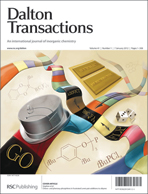Exploring the reactivity of the mixed-metal reagent [(TMEDA)Na(TMP)ZntBu2] (1) towards substituted metallocenebenzoylferrocene 2, this study has found that two competing reactivity pathways are available for the sodium TMP-zincate, namely (i) remote 1,6-nucleophilic addition of a tert-butyl group to the phenyl ring of 2, and (ii) simultaneous alpha-deprotonation of the substituted cyclopentadienyl ring of the metallocene and alkylation (1,2-addition) across the C![[double bond, length as m-dash]](https://www.rsc.org/images/entities/char_e001.gif) O bond of the carbonyl group. A key organometallic intermediate [(TMEDA)Na(μ-TMP)Zn{OC(tBu)(Ph)(η5-C5H3)Fe(η5-C5H5)}] (3), resulting from the latter reaction has been trapped and characterised by X-ray crystallography and multinuclear (1H and 13C) NMR spectroscopy. Its molecular structure revealed a unique two-fold activation of the tert-butyl groups bonded to zinc in the bimetallic base 1, showing for the first time that each alkyl group can exhibit markedly different reactivities (deprotonation vs.1,2-addition) towards the same substrate molecule. Iodine interception of the organometallic intermediates of the reaction between 1 and 2 allowed the isolation and characterization (1H, 13C NMR and X-ray crystallography) of the ferrocenyl derivatives [PhC(OH)(tBu)(η5-C5H3I)Fe(η5-C5H5)] (4) and [4-tBu-C6H4C(
O bond of the carbonyl group. A key organometallic intermediate [(TMEDA)Na(μ-TMP)Zn{OC(tBu)(Ph)(η5-C5H3)Fe(η5-C5H5)}] (3), resulting from the latter reaction has been trapped and characterised by X-ray crystallography and multinuclear (1H and 13C) NMR spectroscopy. Its molecular structure revealed a unique two-fold activation of the tert-butyl groups bonded to zinc in the bimetallic base 1, showing for the first time that each alkyl group can exhibit markedly different reactivities (deprotonation vs.1,2-addition) towards the same substrate molecule. Iodine interception of the organometallic intermediates of the reaction between 1 and 2 allowed the isolation and characterization (1H, 13C NMR and X-ray crystallography) of the ferrocenyl derivatives [PhC(OH)(tBu)(η5-C5H3I)Fe(η5-C5H5)] (4) and [4-tBu-C6H4C(![[double bond, length as m-dash]](https://www.rsc.org/images/entities/char_e001.gif) O)(η5-C5H4)Fe(η5-C5H5)] (5) in a 29% and 24% isolated yield respectively. The low yield observed for the formation of 5 (resulting from the 1,6-addition reaction followed by spontaneous aerobic oxidation during aqueous workup) could be increased to 41% when the reaction mixture was hydrolysed in the presence of the radical oxidant TEMPO.
O)(η5-C5H4)Fe(η5-C5H5)] (5) in a 29% and 24% isolated yield respectively. The low yield observed for the formation of 5 (resulting from the 1,6-addition reaction followed by spontaneous aerobic oxidation during aqueous workup) could be increased to 41% when the reaction mixture was hydrolysed in the presence of the radical oxidant TEMPO.
![Graphical abstract: Assessing the reactivity of sodium zincate [(TMEDA)Na(TMP)ZntBu2] towards benzoylferrocene: deprotonative metalationvs.alkylation reactions](/en/Image/Get?imageInfo.ImageType=GA&imageInfo.ImageIdentifier.ManuscriptID=C1DT11465D&imageInfo.ImageIdentifier.Year=2012)
You have access to this article
 Please wait while we load your content...
Something went wrong. Try again?
Please wait while we load your content...
Something went wrong. Try again?
![[double bond, length as m-dash]](https://www.rsc.org/images/entities/char_e001.gif) O bond of the
O bond of the ![[double bond, length as m-dash]](https://www.rsc.org/images/entities/char_e001.gif) O)(η5-C5H4)Fe(η5-C5H5)] (5) in a 29% and 24% isolated yield respectively. The low yield observed for the formation of 5 (resulting from the 1,6-addition reaction followed by spontaneous aerobic
O)(η5-C5H4)Fe(η5-C5H5)] (5) in a 29% and 24% isolated yield respectively. The low yield observed for the formation of 5 (resulting from the 1,6-addition reaction followed by spontaneous aerobic ![Graphical abstract: Assessing the reactivity of sodium zincate [(TMEDA)Na(TMP)ZntBu2] towards benzoylferrocene: deprotonative metalationvs.alkylation reactions](/en/Image/Get?imageInfo.ImageType=GA&imageInfo.ImageIdentifier.ManuscriptID=C1DT11465D&imageInfo.ImageIdentifier.Year=2012)

 Please wait while we load your content...
Please wait while we load your content...